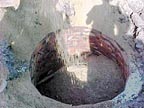
Abandonment of screened wells by filling the casing from top to bottom with neat portland cement usually is an effective way to seal the borehole. If there is an opening along the annular space (outside of the casing), the opening should be sealed with cement grout or a flowable mixture of bentonite pumped through a tremie pipe.
Large wells with open hole completions present a larger concern. If the producing portion of the open hole below the casing has large voids in fractured bedrock or solution features in carbonate rock (cavities), then cement or bentonite may not be a practical solution for plugging the well. Open boreholes where extensive fractures and/or cavities exist can consume very large volumes of bentonite and/or cement. In some cases, hundreds of bags have been used without filling the voids. Besides, sealing all of the voids the grout damages the producing capacity of the aquifer in that area.
Wireline television surveys and borehole geophysical logs can provide a wealth of information on wells where no apparent records exist. Most of you are familiar with the television surveys, which must be run in boreholes where the water is clear to observe the borehole conditions. Television surveys can detect screen lengths, cracks or breaks in casings, location of voids, etc. Borehole geophysical logs, especially caliper logs, can be run to measure the size of the voids, vertically and horizontally (up to a few feet), which in turn can be used to calculate the volume of material needed to fill the voids and casing.
In most cases, it is recommended that the open portion of the borehole be filled with clean crushed rock to within a few feet of the bottom of the casing. Then the crushed rock should be capped with a gravel and coarse sand to a few feet inside of the casing. A small cement plug then should be placed on top of the sand and allowed to set overnight. The next day, the casing should be filled with impermeable natural material to land surface.
Filling the open hole of a borehole with gravel or crushed rock helps restore the aquifer to natural conditions and at a minimum expense. The television or borehole logs can provide all of the information (depths, volumes, etc.) needed to plug the well property.


Report Abusive Comment